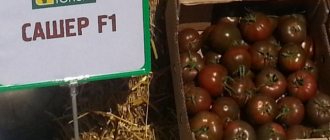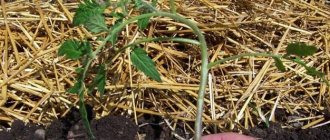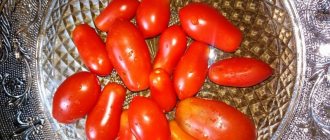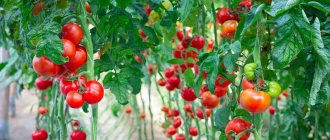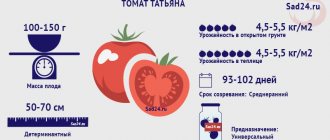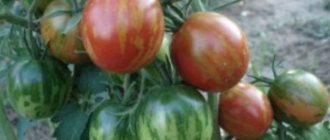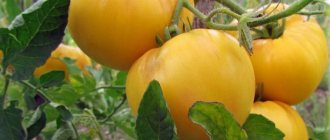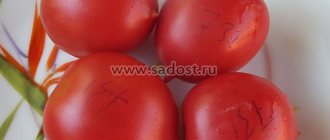Tomatoes are a heat-loving crop native to South America. In most of our country, conditions for its cultivation are far from ideal. Constant temperature changes, cold rains and winds are negative factors present in most regions of Russia. Therefore, domestic gardeners grow many varieties of tomatoes in greenhouses.
Thanks to selective breeding, agronomists have been able to develop tomatoes with increased hardiness. They are not afraid of temperature changes and are undemanding to care. These varieties include the early ripening tomato Zhenechka.
Brief information about the variety
- Bush : determinate, height 35-40 cm.
- Fruits : round in shape, slightly ribbed, rich red color, weight - from 80 to 100 g.
- Productivity : if you follow all the rules of agricultural technology, you can remove up to 3 kg from one plant.
- Resistance : high immunity against fungal, viral and bacterial infections,
- high cold resistance.
- Distribution : the culture was bred specifically for cultivation in regions with cold climatic conditions - in the Urals, Siberia, the Middle Zone, the Moscow region and the Moscow region.
- Application : universal - medium-sized fruits are great for preparing salads, lecho, ketchup, juice and pasta, as well as first and second courses. They are preserved whole, salted and pickled.
- Planting : sowing seeds for seedlings, pattern 3x1 cm, timing - mid-March.
- Soil : the soil should be loose, light, enriched with organic and mineral fertilizers.
- Care : fertilizing, watering, loosening, weeding, no need for gartering or pinching.
- Ripening period : the crop ripens within a month from the moment of emergence.
general characteristics
Bush
Tomato variety Zhenechka of determinant type. The height of the bush is 35-40 cm, foliage and branching are weak. On one plant, 3-4 flower clusters with 5-6 fruits are formed.
The shoots are erect, of medium thickness, green. The leaves are elongated, pointed at the tips, dissected along the edges, emerald green.
The yield is good - if you follow all the rules of agricultural technology, you can remove up to 3 kg of tomatoes from one bush.
This crop was bred specifically for cultivation in regions with cold climatic conditions - in the Urals, Siberia, the Middle Zone, the Moscow region and the Moscow region.
The growing season is 80-86 days; from the moment the sprouts appear, about 3 months must pass to obtain the first harvest.
():
The small size of the bush allows you to grow tomatoes of this variety as a balcony crop. The volume of soil for each plant should be at least 5-6 liters.
Fruit
Tomatoes are round in shape, slightly ribbed. The color is rich red, weight - from 80 to 100 g. The taste is sweet and sour. The surface is dense and does not crack during heat treatment.
Universal use - medium-sized fruits are great for preparing salads, lecho, ketchup, juice and pasta, as well as first and second courses. They are preserved whole, salted and pickled.
Harvest ripening
The harvest ripens smoothly and is harvested either fully ripe or unripe. Brown fruits ripen well at home. Stored for no more than 1.5 months in a dry and cool place.
Features of cultivation and storage
To obtain an early harvest, tomatoes are transplanted into prepared shelters. A tunnel made of covering material saves you from night frosts in May; even cold-resistant varieties of tomatoes cannot tolerate temperatures close to 0 ° C or negative temperatures.
The bed for tomatoes is chosen taking into account crop rotation. The optimal predecessors would be beets, peas or cucumbers.
Despite its early ripeness, the variety is perfectly stored. For large volumes of harvested crops, some are placed in a cellar equipped with ventilation. Tomatoes are placed in wooden boxes, sometimes sorted, removing overripe or rotten specimens.
Advantages and disadvantages
The description of tomatoes includes several advantages:
- compact size, which allows cultivation in small areas;
- versatility of use;
- excellent taste and commercial quality;
- fruits tolerate transportation well;
- the bush does not need gartering or pinching, which makes care much easier;
- ultra-earliness;
- high immunity against fungal, viral and bacterial infections;
- good cold resistance.
The variety is immune to diseases
The only drawback is that the fruits have a high acid content, but given the early ripening, this disadvantage is hardly noticeable.
Rules for growing seedlings
You should start sowing seeds for seedlings in the second ten days of March. Before planting on the plot, the tomatoes will get stronger, form a long stem - 25-30 cm in height and grow 5-6 leaves.
Seed preparation
High-quality seed material is the key to strong seedlings and bush productivity. You can purchase it at a gardening store or collect it from last year's harvest.
Preparation includes several stages.
- Soaking for half an hour in salt water (10 g per 1 l), which helps to reject non-viable specimens. The seeds that rise to the surface are disposed of, and the ones that settle are washed with clean water.
- The second stage is etching in a strong solution of potassium permanganate for 30 minutes.
- After this treatment, the seeds are rinsed again, then irrigated with any growth stimulant. For example, either Epin or Zircon.
- The final procedure is to wrap the seed in a damp cloth and keep it in a dark and warm place for 48 hours. During this time they will swell and hatch. To prevent them from drying out, they are irrigated with warm water from time to time.
():
To accelerate the emergence of seedlings, it is necessary to use special stimulating substances that act specifically on the seed coat and the embryo. Stimulants such as Heteroauxin and Kornevin are not used for these purposes. These drugs are used only for vegetative propagation, for rooting cuttings or stimulating root formation in tree and shrub seedlings.
Sowing container
You can sow tomatoes in boxes for growing seedlings or plastic containers about 10 cm high.
To avoid picking and injury, seed material is sown in disposable containers - plastic cups or cassettes.
The best option is peat pots. After transplanting to the garden bed, they decompose easily.
The planting container must have drainage holes to drain excess liquid.
():
Growing tomatoes with picks allows you not only to save space in the initial stages of growth, but also to obtain better-quality seedlings, because Injuring the root when picking a tomato stimulates the formation of lateral roots and a developed root system as a whole.
Priming
Tomatoes like to grow in light, loose, fertile soil with a neutral pH level. For sowing, purchased soil for cultivating vegetable plants is suitable.
You can also use a homemade soil mixture - mix garden soil, last year's manure or compost, sand (sawdust) and wood ash in a ratio of 2:1:1:1.
The nutrient substrate is steamed in the oven or poured with boiling water to destroy all pathogenic microbes.
Sowing technique
The cups filled with soil are placed on a pallet in a place with diffused daylight. Make one hole in each container and place 1-2 seeds in it. The seeding depth is 1 cm.
Sprinkle with a thin layer of soil-sand mixture (1:1). Irrigate from a sprayer with warm and settled water, cover with a transparent film or glass.
Features of care
After sowing, tomatoes require careful care and attention, which will ensure good germination and healthy seedlings:
- stable heat within 25-28°C;
- humidity not higher than 60%;
- spraying the soil as it dries;
- daily diffused light for at least 4 hours;
- removal of weed sprouts;
- ventilation every day - 30 minutes.
Shoots need to be hardened off
In a week, massive shoots will appear - then you can remove the shelter and move the sprouts to a well-lit place with a low temperature of 16-18°C.
This way the tomatoes will stop stem growth and begin to rapidly grow their root system. After 5-6 days, the seedlings are returned to their previous conditions.
Characteristics and description of the tomato variety Zhenechka, its yield
To grow tomatoes in open ground in the Urals, it is necessary to choose varieties with a short growing season of 80-100 days. Tomato "Zhenechka" can be grown both in open and closed ground.
Description of the variety
The Zhenechka tomato is a super early variety suitable for growing in risky farming areas of the Urals and Siberia. This variety is suitable for growing in open ground under short summer conditions, during which time the fruits have time not only to form, but also to ripen.
- The plant is determinate, non-spreading, compact. Bush height 35-45 cm.
- Branching and foliage are average.
- No formation required.
- Super early variety: from germination to the beginning of fruit ripening 80-87 days.
- Fruiting is friendly and stable.
- The fruits are formed close to the stem. Only 3-4 clusters with fruits weighing 80-100 g.
- The fruits are fleshy, slightly ribbed towards the stalk, red, round.
- The pulp of the fruit melts in the mouth, sweet with a slight sourness.
- Productivity 3-4 kg per bush.
- Resistance to late blight.
READ MORE: Tomato Red Robin: reviews on yield, characteristics and description of the variety, photo of the plant
For the Urals and Siberia, it is advisable to plant seedlings in the ground without fear of frost after June 4-10. Tomato seedlings are ready for planting at the age of 54-60 days. Knowing this, it is easy to calculate the optimal time for sowing seeds: April 6-10.
Before you start planting tomatoes, you need to prepare the following materials and tools.
- Directly tomato seeds Zhenechka.
- Priming.
- Container for planting seeds.
For the emergence of friendly shoots, it is necessary to carry out pre-sowing culling and seed treatment. To do this, dissolve 1 tsp in 200 ml of water. salt and drop the seeds. Some of the seeds will sink - they need to be dried and planted, the remaining seeds will float on the surface - they need to be thrown away. Before sowing, soak the seeds in a solution of stimulants or microelements for 6 hours.
You can prepare the soil yourself from a mixture of disinfected turf soil, compost, peat, and ash. If the soil is not light enough, sand or coconut substrate is added to it. You can buy soil for nightshades in the store. Growing seedlings in peat tablets is gaining popularity.
The soil substrate for growing tomatoes Zhenechka must be moisture-absorbing, breathable, saturated with essential microelements with a good lumpy structure
Different containers are used for sowing: these can be seedling cassettes or plastic cups. Containers must be thoroughly washed and disinfected, especially if reused. Any containers must have drainage holes, otherwise the seedlings will be susceptible to blackleg disease.
You can grow tomato seedlings intended for open ground, just like other varieties and hybrids. It is preferable to grow the tomato variety Zhenechka without going through the picking stage.
- Fill the prepared container with soil and pour plenty of warm water.
- Bury the seeds into the soil 1-1.5 cm and sprinkle with soil.
- Place the pots in a warm, bright place and cover with a transparent material, such as glass or film.
- After a week, shoots appear, the film must be immediately removed and the temperature reduced to 14-16°C.
- Additional lighting is necessary to prevent seedlings from stretching.
- The temperature is lowered by ventilating the room, avoiding drafts. The lower temperature will not allow the seedlings to stretch out and will accelerate the development of the root system.
- 5-6 days after emergence, the temperature is again increased to 22-25°C and the weaker plant is removed.
- Caring for seedlings consists of regular watering followed by loosening the soil. The humidity of the soil mixture should be 70-80%.
Before planting in open ground, seedlings are hardened off (accustomed to being in conditions close to open ground). In the Urals, hardening begins in early May, excluding direct sunlight. The air temperature cannot be lowered below 10°C. During hardening of seedlings, the soil in the pots should be moistened, otherwise the leaves will turn yellow and wither; in the worst case, blackleg damage may occur.
Tomatoes can be grown in one place for no more than 2-3 years, with the obligatory application of organic fertilizers of at least 10 kg per 1 sq.m.
The best predecessors for tomatoes grown in open ground are cucumbers, cabbage, and onions. It is not recommended to plant them in a bed where nightshades previously grew. Strong, bright green, not elongated seedlings with 7-9 leaves are the key to a good harvest.
Tomato seedlings are ready for planting in the ground when the air temperature becomes stable. It must be at least 8°C. The optimal soil temperature for tomatoes should be from 12°C. To obtain an earlier harvest, some gardeners prepare tunnels with covering material or film, especially if there is a threat of night frosts. At the beginning of June, the need for shelters disappears.
- Landing is carried out in cloudy weather or at sunset.
- Seedlings are planted in ridges or on a flat surface.
- Planting pattern 70*30 cm. Per 1 sq.m. mix 6-8 plants. Plantings should not be thickened, as in this case there will be insufficient lighting for each bush, and the amount of harvest will decrease.
- It is necessary to add rotted manure, mineral fertilizers, ash to the holes and pour plenty of warm water.
- When planting, the plants are buried, leaving 6-7 leaves, the rest are torn off.
- If the seedlings have outgrown, you need to dig horizontal trenches and place the stem in them, after tearing off the leaves. There will also be 6-7 leaves on the surface.
- If necessary, plants are replanted to form new roots.
- Tomato Zhenechka is tied to vertical supports, otherwise it may lie down under the weight of the crop.
- There is no need to form bushes, but after the first cluster has formed, the lower yellowed leaves can be cut off.
- Further care comes down to regular watering once every 7 days, weeding and fertilizing with fertilizers containing minerals and organic matter. Plants need to be fed only after abundant watering.
Tomato varieties are best suited for salads, stewing, baking and canning; fresh consumption is also possible.
The variety has high resistance to diseases and unfavorable conditions. The Zhenechka tomato is an early-ripening variety; the main harvest occurs at the end of June, so it is not afraid of the August cold period, and therefore late blight will bypass.
READ MORE: What grass can be given to piglets, a list of plants that cannot be given
The Siberian variety was bred specifically for productive cultivation in the Ural and Siberian regions and is resistant to weather changes. If there is a risk of infection with fungal diseases, plants are treated with a solution of phytosporin, diluted according to the instructions.
Reviews from gardeners
“For several years in a row I have been growing Zhenechka tomatoes, the most delicious for early consumption, with a little sourness. It has a very thin skin and amazing pulp.”
“It tastes like childhood. It is especially pleasant to pick and eat red tomatoes straight from the bush when they are still green in the greenhouse. Now there are so many different varieties, you can’t try them all, so I’m planting several different hybrids to try (Alsu, Nepasynkuyuschiy with a spout). Some grow, some not so much, but the Zhenechka variety always helps out. With it you will not be left without tomatoes, even if other varieties fail. I recommend it to everyone.”
These varieties include the “Zhenechka” tomato, which, according to the characteristics and description of the variety, belongs to super-early tomatoes, and reviews and photos indicate a very impressive yield for early varieties.
The tomato belongs to the early varieties with a ripening period of 80-85 days after germination. The plant is determinate, low-growing. Fruit ripening is consistent. It consistently produces a harvest of small, tasty fruits even during cold weather. The “Zhenechka” variety was bred for cultivation in central Russia, as well as in the Urals and Siberia.
The main thing about the variety
The plant is short - 35-45 cm high, a bush of medium branching, compact, medium leafy. Does not require shaping or pruning (only leaves growing up to the first cluster are removed).
The fruits are borne in clusters - up to 4 per plant. Productivity – up to 3 kg per bush. The fruits are quite smooth:
- round shape, slightly ribbed;
- weight from 80 to 100g;
- the color of ripe tomatoes is red;
- the pulp is juicy, sweet and sour;
- do not crack;
- The use of tomatoes is universal - for preparing salads, various dishes, and for preservation.
Early tomatoes have a great advantage over other varieties, since their fruiting ends by the time the August fogs and cold snaps arrive.
Since the variety was bred specifically for areas with risky farming, it is characterized by resistance to temperature changes and unpretentiousness.
For prevention, if there is a risk of disease, plants are treated with phytosporin and copper-containing preparations.
The most dangerous pests of tomatoes are Colorado potato beetles, wireworms, beetles (chafer beetle larvae), as well as whiteflies and slugs.
To repel the Colorado potato beetle from plantings, use birch tar diluted in liquid laundry soap. The composition is sprayed onto the soil around the plants.
Colorado beetles are collected by hand, avoiding the hatching of larvae, which can leave the plant without leaves.
If terrestrial insects are quite easy to detect, then wireworms or beetles can only be detected if the results of its harm are already visible - the plants are oppressed and wither. By digging up the soil near the roots, you can find these yellow worms.
The main advantage of the Zhenechka variety is its early ripening. In most reviews, summer residents also note other positive characteristics:
- unpretentiousness;
- compactness of the bushes, allowing you to grow tomatoes occupying small areas;
- stability;
- high yield for early varieties;
- resistance to diseases.
Some people consider the sour taste of tomatoes to be a disadvantage, but against the backdrop of early ripening of the fruit, it is leveled out.
In order to grow Zhenechka tomato seedlings by mid-May, seed preparation must begin on March 10-15.
Seeds are treated before sowing:
- Disinfection in a solution of potassium permarganate or phytosporin (holding time 20 minutes), followed by rinsing in water.
- Soak in a solution of microelements or stimulants for 6 hours.
You can buy ready-made soil for planting seedlings or make it yourself from a mixture of disinfected turf soil, compost, peat, and ash. If the soil is not light enough, sand or coconut substrate is added to it.
Transfer rules
The optimal time for transplanting tomatoes into the garden is mid or late May. By this time, the threat of return frosts will have passed, it will become warmer outside and the soil will warm up to a temperature of 10-12°C. Typically, seedlings are transplanted at the age of 55-60 days.
Before this, the tomatoes undergo a 10-day hardening process. They are taken out into the fresh air every day and kept for several hours. During the last 24 hours they are left to spend the night outside under cover.
Preparing the site
This is a sun-loving crop, so it needs to be planted in a sunny and wind-protected area, where there is no swamp. The soil should be low in alkalinity and acidity.
The beds are prepared in the fall:
- choose a place where the best predecessors of tomatoes previously grew - cucumbers, legumes, cabbage or beets;
- cleared of weeds and vegetation residues;
- sprinkle with a nutrient composition - 10 kg of humus (compost), 3 kg of wood ash, 100 g of superphosphate and 80 g of potassium sulfate per 1 m²;
- carry out deep digging without breaking up lumps.
If the soil is acidified, you need to add an additional 300 g of chalk, dolomite flour or slaked lime.
In the spring, 2 weeks before the planned planting of seedlings, the bed is treated with a solution of Fitosporin. It helps to destroy all pathogenic bacteria and improve the nutritional value of the soil.
Planting scheme
This is a low-growing and compact variety, so the optimal planting pattern will be 40x50 cm. Dug holes according to the size of the root system of the seedlings, spill 1 liter of water. After absorbing moisture, the roots are lowered, sprinkled with earth, lightly compacted and hilled.
In the first 5 days, seedlings will need to be provided with shade from the scorching sun, and at night shelter from the cold.
Features of agricultural technology
In order to grow Zhenechka tomato seedlings by mid-May, seed preparation must begin on March 10-15.
Sowing and caring for seedlings
Seeds are treated before sowing:
- Disinfection in a solution of potassium permarganate or phytosporin (holding time 20 minutes), followed by rinsing in water.
- Soak in a solution of microelements or stimulants for 6 hours.
You can buy ready-made soil for planting seedlings or make it yourself from a mixture of disinfected turf soil, compost, peat, and ash. If the soil is not light enough, sand or coconut substrate is added to it.
Care requirements
The characteristics of the variety include high yield, but this requires careful care.
Watering
It is better to water the plants in the morning or evening
The first irrigation is carried out a week after transplanting tomatoes to the site. Water is poured at the root at the rate of 0.5 liters per plant.
Subsequent moistening is carried out taking into account the amount of precipitation. In dry summers, tomatoes must be watered before flowering and at the stage of fruiting. The dose of liquid is increased to 2 liters for each bush. Do this early in the morning or in the evening, when the sun is not so active.
After watering, the soil is loosened to maintain its aeration. The rows are weeded and weeds are removed. For stability, the bushes are covered with garden soil.
Fertilizers
During the entire season you need to feed 3 times.
20 days after planting in the garden, the tomatoes are watered with a urea solution (30 g per 20 l). 0.5 liters of working fluid is enough for one plant to stimulate intensive growth of green mass and roots.
Before flowering and during the fruiting period, a complex mineral composition of 15 g of superphosphate and 10 g of potassium salt will be required. The dry ingredients are dissolved in a bucket of water, and 0.5 liters of liquid fertilizer is poured under each bush.
Such nutrition is combined with watering to avoid burning the roots.
To increase immunity from diseases, improve the quality of flowering and fruiting, the bed can be sprayed twice with a solution of boric acid (0.2 liters per 1 liter of hot water - 55-60°C).
Formation and stepsoning
The plant does not need these procedures. The only thing that needs to be done is to tear off all the foliage and stepsons at the bottom, which only take away excess moisture and nutrients from the tomatoes.
In a harvest year, the bushes are tied to a trellis or stake to avoid breaking off the stems under the weight of the fruit.
Disease Prevention
The Zhenechka variety is resistant to many Solanaceae diseases, but prevention will not harm it.
Two treatments are carried out with fungicides (a solution of copper sulfate or Bordeaux mixture) - 3 weeks after transplanting the seedlings to the garden bed and a week before the bushes bloom.
For pests, folk recipes are used - an infusion of garlic, onion, hot pepper, tobacco or an ash-soap solution.
Spicy herbs and plants are sown between the rows and the soil is sprinkled with ash.
To avoid infection, it is recommended to plant high-quality and treated seed, follow the planting scheme and crop rotation rules.
Description of the bush
In order for seedlings to grow faster, they need a sufficient amount of sunlight, at least 12 hours a day.
If it is not enough, then artificial lighting is necessary. Two weeks after picking, a new root system begins to form in the seedlings, and the bushes themselves grow faster. After the formation of the third true leaf, the seedlings need even more sunlight. Also during this period, feeding is very important.
2 weeks after picking, a solution of urea, superphosphate, sulfate and potassium should be added to the seedlings. After 10 days, fertilizing must be repeated.
Seedlings are planted in a permanent location at the end of May. If May was too cold, then planting should be postponed until June. The distance between the bushes should be at least 40 cm. When the tomato begins to grow, it is recommended to tie it to a support. Since the Pink King variety is a tall hybrid, the bushes can break under the weight of the fruit and cannot be done without a garter.
Hardening off plants will reduce the stress they receive when transplanted to a new location. This must be done 10 days in advance. Take the seedlings outside, starting from 20 minutes and ending all day.
Proper care and proper formation of the bush will help you get a good harvest from the plant. A large number of stepsons weakens the plant, and the fruits will be smaller.
The best result is achieved when the plant is formed into 1–2 stems. Attachment to supports is required. To increase yield, you can remove the growing point.
3–4 plants are planted per 1 m2. It is imperative to remove weeds, hill up and loosen the soil.
Since the “Pink Tsar” variety is a tall tomato, they must be pinched and tied up. The bush is usually formed into two stems, and excess stepsons are removed until they grow to 4-5 cm.
Water the tomatoes with warm, settled water, taking into account the stage of development they are at:
- Before the flowers appear, the bushes are watered every 4 days at the rate of 2 liters of water per plant;
- During the period of flowering and the formation of ovaries, the plants are watered weekly with a large amount of water - at least 5 liters for each tomato;
- When fruits are forming, tomatoes need less watering - 2 liters per bush once every 7 days.
Mulching the beds with humus or straw will help retain moisture in the soil.
“Pink Tsar” tomatoes respond well to various feedings. Minerals and organic matter are added to the soil: mullein, bird droppings, wood ash.
When forming ovaries and fruits in tomatoes, fertilizers with potassium and phosphorus should be used.
The bush is quite tall, and therefore it should be regularly tied to trellises. Also, to achieve maximum yield, you should support the bush with wooden supports. Seeds do not need to be processed before planting. The following maintenance steps are standard: regularly loosen the soil and weed the beds.
The plant vegetative form is quite tall and a height of 180 cm is absolutely not the limit.
By planting tomatoes in greenhouses and hothouse shelters, vegetable growers can easily spread the tops horizontally and get an additional late, autumn harvest.
If you plant this plant in a garden bed or greenhouse, you don’t have to mark it because its leaves will be different from other varieties. They are large, dense, rich green in color and look like velvet.
During the time that the “king” has been on the market, many vegetable growers have already managed to appreciate its charms and their opinions regarding taste coincide. The fruits received “excellent” during a tasting commission evaluation, and tomato lovers fully confirm these indicators.
Tomatoes are very tasty. The tomato pulp is tender and at the same time not tearful, but moderately rich, pliable, and fleshy. There are six or more seed chambers. They are filled with pulp and not a lot of seeds.
The fruits are large, weighty, ranging from 200-300 g.
The fruits have a flat-round shape, ribbed, and medium density.
The skin of the fruit is moderately dense, but protects the tomato well from cracking.
The yield of the variety is not very high, ranging from 7-8 kg per meter of garden. However, vegetable growers, for whom the main thing in tomatoes is not the commercial value, but the exquisite taste, quite agree with this quantity.
Mistakes of summer residents
Growing this crop requires some knowledge and skills, so beginners are not always able to get a tasty and abundant harvest in the first year of planting. This happens for several reasons:
- using expired or infected seed that does not germinate well and produces diseased seedlings;
- sowing in too small a container, as a result, the seedlings suffer from a lack of nutritional components and space for root development - they turn yellow and wither;
- lack (or excess) of light or moisture, which also negatively affects the development of young shoots;
- transplantation without accustoming to sunlight and fresh air - such sprouts usually quickly wither from freezing or turn yellow from overheating in the sun;
- lack of basic care - watering, fertilizing, preventive treatments, loosening and weeding;
- tomatoes growing in weed thickets will produce a meager harvest and begin to get sick.
My low-growing tomatoes 2017
10 BEST LOW GROWING VARIETIES OF TOMATOES FOR OPEN GROUND. According to reviews from gardeners
I WILL DEFINITELY PLANT THESE TOMATOES!!!NEW THIS YEAR!
Rules for sowing tomatoes Zhenechka: methods of controlling pests and diseases
Since Zhenechka is an early tomato, its fruiting ends by the time the summer season begins to decline and cold and fog sets in. Therefore, the plant is not susceptible to diseases such as late blight. But it is still necessary to treat it with phytosporin or preparations that necessarily contain copper for preventive purposes. It is also important to remember that bushes can be attacked by pests - the Colorado potato beetle and whitefly, slugs and May beetle larvae.
tomato Erofeich - description and characteristics of the variety
The low-growing tomato variety Zhenechka is famous among gardeners for its ease of care and excellent harvest in all weather conditions. What are the characteristics of the variety? Let's look further.
Reviews from gardeners
Those who planted Zhenechka tomatoes were satisfied and gave a positive description:
- early ripening of vegetables is one of the most important qualities of a plant that attracts gardeners from different regions;
- the yield is stable, there is no need for pinching or gartering, which is why the variety is so popular among beginners;
- Universal tomatoes can be used in all dishes and preparations for the winter.
Due to their high marketability and excellent taste, tomatoes are cultivated in both private and industrial gardening.
Features of cultivating tomatoes in open and protected ground
The Zhenechka tomato variety is rarely grown in a greenhouse . If it is planted in protected soil, it is important to maintain an optimal humidity level, which should not exceed 60%. To do this, ventilate the room daily.
In open ground, during the first two weeks after planting, plants are covered with film in the evening, protecting them from night frosts. If the temperature outside drops below 10 degrees, then this is done during the day.
Mulching beds in open ground is mandatory . This will protect the plants from frost, diseases and harmful insects.
